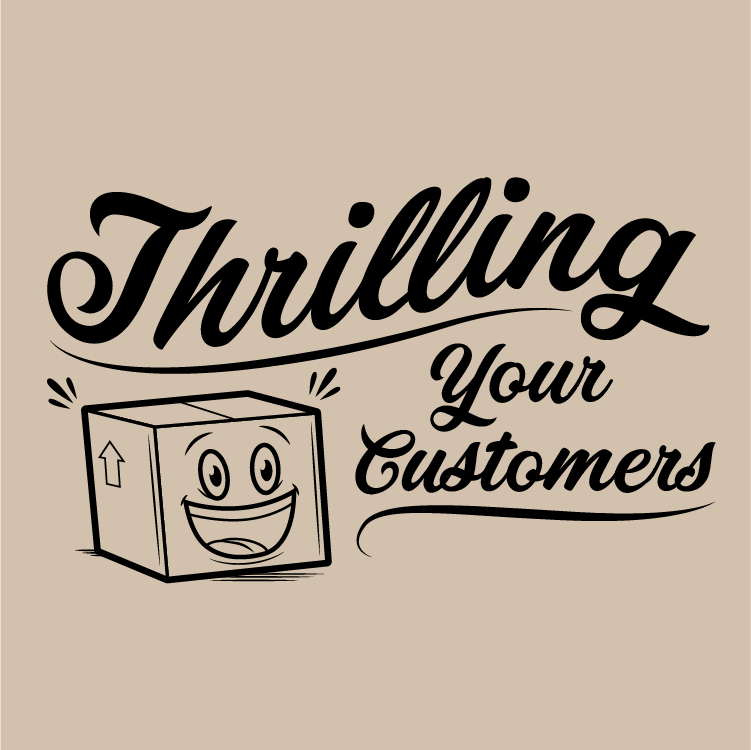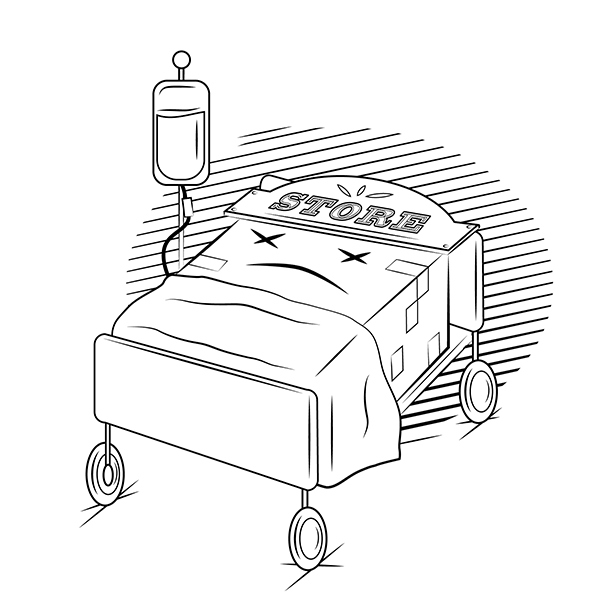
Thrilling Your Customers
Below is an excerpt from my latest book for small business owners, Thrilling Your Customers. Get the full book here.
Chapter One:
Why Brick and Mortar is Dying

We hear the sad stories in the news almost every day. Sometimes we even see it for ourselves when we visit the local mall or drive down what used to be a busy shopping street that is now plastered with For Lease signs instead of shop names. Windows are dark and dusty, no one is cleaning up the trash anymore. More homeless people are camping out in storefronts. It’s like that scene from Back to the Future II where Marty McFly ends up in a nightmarish, alternate future. Except that it’s actually starting to happen in the real world, and brick and mortar retail stores really are dying.
Why is this happening? Many business owners and the media are quick to blame Amazon and ecommerce. While that may be one part of the puzzle, we need to look deeper. Let’s jump into the Wayback Machine and look at some history.
Video Killed the Cinema Star
Back in the 1980s when video stores started to spring up and the VCR was becoming affordable for middle-class families, the big movie studios were in a panic. Several of them got together and actually lobbied the U.S. government to put a stop to it. They were spooked by these little video stores. They were sure that families watching movies at home on the couch would destroy cinema. Spoiler alert: It didn’t happen. Video stores eventually died out anyway. These days we’ve swapped tape and DVD rentals for Netflix and other streaming channels. Yet even with the popularity of those platforms, millions of people still go to movie theaters to watch new films.
Panic at the Costco
Like the movie studios forty years ago, retailers are in a similar panic right now with the threat of ecommerce. Amazon started doing business in 1994 and is currently the leader in ecommerce. While other big box stores like Target, WalMart and Barnes & Noble also have ecommerce sites, Amazon is different because it has no brick and mortar location. They make it easy to avoid the freeways, parking, and the lines. Customers can even get their item delivered the same day – often at cheaper prices than the store down the street. That’s hard for a big box store to beat, let alone a mom-and-pop retail shop.
It seems that ecommerce, especially Amazon, is easy to blame for the failure of Main Street and mall stores. The general feeling is that if you can’t compete with Amazon, it’s an unfair situation and you’re doomed to fail.
That is a cop out.
Retail stores trying to compete with Amazon’s ease of buying and inhumanly fast delivery are missing out on the one thing that Amazon can’t compete on: connection, both human and environment.
On the internet, No one can smell your books
When was the last time you bought a book? Was it online or at a local bookstore? If you’re a book lover, you know that part of the appeal is taking down a book and feeling the weight in your hands. The smell of the paper and ink are visceral. If it’s a little musty, that’s a bonus. Especially in used book stores, there’s a sense of history and story that we don’t get from a computer screen. Who owned this book before? When you see an inside cover inscribed, “To Daniel, 1977,” the mystery of who Daniel is and who gifted him the book becomes as much a part of the story as the actual tale the author wrote.
People who love books love being surrounded by them. It’s impossible for a book lover to pass any kind of bookstore and not stop, even if only for a moment. That’s powerful.
I’m only human, of flesh and blood I’m made
And what about the people? It’s ironic, but the more retail stores replace people to make service faster, the more they start losing out to ecommerce. Self-checkouts are becoming ubiquitous. It may be streamlining the shopping experience, making checkout more efficient, but there’s something missing. Customers shopping retail, or going to a theater or a restaurant still expect some kind of human interaction. Having humans in a shop can be comforting. Amazon and other ecommerce stores can’t offer that. I truly believe that in the end, people will choose human interaction over convenience.
To flip the original question of this chapter to the more actionable, we should ask: How can we keep brick and mortar stores alive?
It’s Different for Shops
First, stop trying to compete. That doesn’t mean giving up and letting Amazon win. In fact, this is a very positive step to take, because once you eliminate the stress of trying to keep up with Amazon, you can take better, more thoughtful steps to make your own store uniquely valuable.
You can still do your own version of online business. It’s not only a great idea, these days customers actually expect you to have at least a website. So why not expand your reach by offering products online through Amazon Marketplace, Etsy or other established stores? Leverage their power to grow your business. Just don’t try to imitate their models.
Be a Racehorse – er, Resource
If you have a physical location run by humans, you have a huge advantage. There’s a lot you can do to bring in people that isn’t limited to only selling products or services. You can host workshops, give free demonstrations, provide information that relates to your business that’s truly helpful to potential customers. When people keep coming back to your store because you’re a resource, they will eventually buy and even better, bring their friends.
This is also true if you operate at farmer’s markets, events or pop-ups. You can still create an environment that engages people and gets them interacting, rather than looking at yet another table of stuff to buy.
Similarly, you can create events where your local community members can participate. Join your local Chamber of Commerce and offer to host events at your location. If you’re a bookseller, host signings or encourage customers to have their book club at your shop. Serve tea and cookies (free of charge) to the group.
If you make your business a local resource and not just a place to buy more stuff, you will create something that people will actively choose over ecommerce every time.
Create an environment for interaction
You have a very special opportunity every time a customer visits your store. You can engage in conversations with them, which is something they can’t get when shopping from their keyboard. I’ll get into this in more detail in a later section, but for the moment just ponder the notion that every time a human being enters your store, you already start with an advantage over ecommerce. What you do with that opportunity is up to you, and we’ll get into more depth on this so you have actionable steps you can take.
Again, when I say “store,” I am also including pop-ups, farmer’s markets and other events. This is important because even though your locations are temporary, you can create these environments and experiences that people love.
Online sellers still have hope
Even if you only sell online, you can still take away some valuable lessons from this chapter. Although you don’t have real people walking into a space with whom you can interact, there are still great opportunities to create connections with potential customers. The same principles this book that apply to brick and mortar apply to online stores as well.
Think of social media and email as your physical space. In those platforms you can interact with people from all over the world with almost non-existent overhead.
Consider selling at a local market or event where you can meet people face to face. Even if your sales at the event are low, you are still creating a huge opportunity for potential customers to know you and find you online.
Being small actually gives you a major advantage over Amazon and other big ecommerce retailers. Embrace being small. It’s a gift, really. Use your magical powers of personal connection to bring people in to your space, whether it’s online, in a shop or a tent at a market.
This excerpt from Thrilling Your Customers is ©2020 by D.J. Billings. No part of this text may be used without written permission from the author.